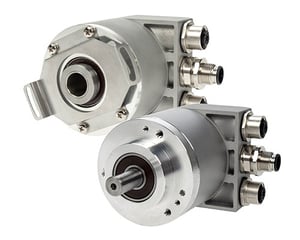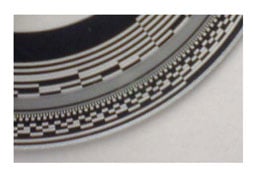Shafted Rotary Encoders
Dynapar offers a wide range of shafted rotary encoders that mount to a motor or driven shaft via a flexible coupling.
Learn More
Other Categories
Optical Rotary Encoders
Magnetic Rotary Encoders
Hollow-Shaft Encoders
Hub-Shaft Encoders
Shaft Encoders
Miniature Encoders
Hazardous Area Encoders
Non Contact Encoders
Bearingless Encoders
Ethernet Protocol Encoders
Service & Support Overview
Product Quicklinks
Competitor Parts List
Discontinued Encoder Guide
Literature Library
RMA Request
Technical Support
Product Manuals & Installation Guides
Knowledge Center
Technology
How to Choose Feedback
Application Examples
Case Studies
Encoder Issues and Troubleshooting
White Paper Downloads
Literature Library
Power Point Downloads
Videos
Featured Links
Motor Encoders
Quadrature Encoders
Optical Encoders
Magnetic Encoders
How to Specify a Resolver
Draw Wire Encoders
Hall Effect Encoders
Encoder Accuracy vs Resolution
Absolute encoders are feedback devices that provide speed, position information by outputting a digital word or bit in relation to motion. Unlike incremental encoders that output a continuous stream of ubiquitous pulses, absolute encoders output unique words or bits for each position.

By outputting a digital word or bit instead of a stream of pulses, absolute rotary encoders offer several advantages:
Speak with a Dynapar expert to learn more about absolute encoders.
Absolute encoders can be categorized based on their sensing technology type (optical or magnetic) or their output over multiple turns of the motor shaft (single-turn or multi-turn).
Optical absolute encoders use a code disc with markings and an LED that shines light through the code disc. As the disc turns with the motor shaft, changes in positions can be detected. For magnetic absolute encoders, the optical markers are replaced by magnetic poles and the LED is replaced by a magnetic sensing array.
While all absolute rotary encoders provide feedback based on the rotation of shaft (position of the encoder within 360 degrees or single turn), applications differ based on the requirement to know how many times the encoder has made a complete rotation or multiple turns. Multi-turn absolute encoders offer additional feedback for the number of 360 degree turns.
Learn more about single vs multi-turn absolute encoders here
 An absolute rotary encoder determines its position using a static reference point. The method is slightly different depending on whether the absolute rotary encoder is optical or magnetic, but the principle is the same either way.
An absolute rotary encoder determines its position using a static reference point. The method is slightly different depending on whether the absolute rotary encoder is optical or magnetic, but the principle is the same either way.
Absolute encoders work by outputting a digital word of bit as the shaft rotates. There are two discs, both with concentric rings with offset markers. One disc is fixed to the central shaft; the other moves freely. As the disc turns, the markers along the track of absolute encoders change position on the fixed disc. Each configuration along the disc of an absolute rotary encoder represents a unique binary code. Looking at the binary code within the absolute rotary encoder determines the absolute position of the object. For optical absolute encoders, the marker is an opening which lets through light. For magnetic absolute encoders, the markers are a magnetic sensor array that passes over a magnet and detects the position of the magnetic poles.
Absolute encoders offer unique advantages over incremental encoders. They have a unique code for each shaft position, meaning that they can provide very unique position information as no two positions on a track are identical. They measure actual position by generating a stream of unique digital codes that represent the encoder’s actual position and therefore do not require an index or reference point. This also provides absolute encoders an advantage in applications returning to a home position may present issues in the event of a power loss.
Absolute encoders also offer higher resolution options compared to incremental encoders. While incremental encoders must add more increments to a single track on a code disc and are thereby limited to the physical size of the disc and the number of pulses that can be decoded vs the rotating speed of the encoder (frequency response), absolute encoders add additional tracks to achieve higher resolutions and do not continuously output a stream of pulses. Instead they are limited by the number times the encoders is interrogated within a given sample period of baud rate.
Learn more about specifying absolute encoder resolution here
If overall system simplicity matters more than performance, then there are alternatives to absolute encoders including incremental encoders and resolvers
Resolvers are electro-mechanical precursors to encoders, based on technology going back to World War II. An electrical current creates a magnetic field along a central winding. There are two windings that are perpendicular to each other. One winding is fixed in place, and the other moves as the object moves. The changes in the strength and location of the two interacting magnetic fields allow the resolver to determine the motion of the object.
The simplicity of the resolver design makes it reliable in even extreme conditions, from cold and hot temperature ranges to radiation exposure, and even mechanical interference from vibration and shock. However, the forgiving nature of resolvers for both origin and application assembly comes at the expense of their ability to work in complex application designs because it cannot produce data with enough accuracy. Unlike absolute encoders, resolvers only output analog data, which can require specialized electronics to connect with.
Incremental Encoders determine relative position, looking only at the differences between measurements. The encoder engine sends out pulses in channels (called quadratures) and the offsets in these pulses indicate motion.
Incremental encoders provide excellent speed and distance feedback and, since there are few sensors involved, the systems are both simple and inexpensive. However, incremental encoders are susceptible to environmental factors and they can lose resolution at high speeds due to output frequency limitations. They are also limited by only providing change information, so the encoder requires a reference device to calculate motion.
The absolute rotary encoder itself understands the positioning information – it doesn’t need to rely on outside electronics to provide a baseline index for the encoder position. Absolute encoders enable applications which rely on non-linear positioning to work without additional external components.
In real life, absolute encoders allow more precision work from applications:
Especially when compared to resolvers and incremental encoders, the obvious strength of absolute encoders is how their positioning accuracy affects the overall application performance.
© Copyright Dynapar 2025 All Rights Reserved